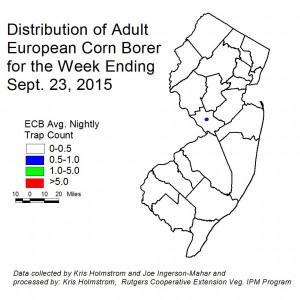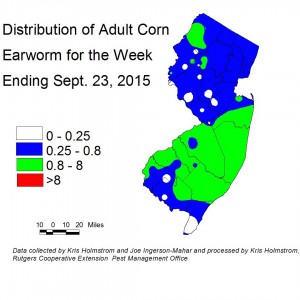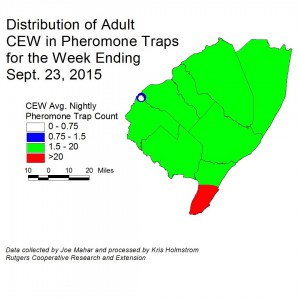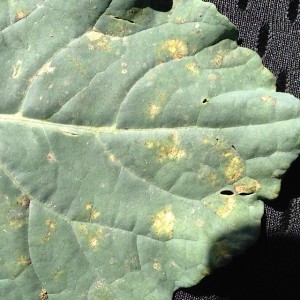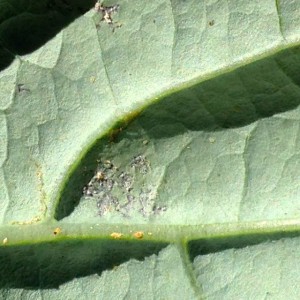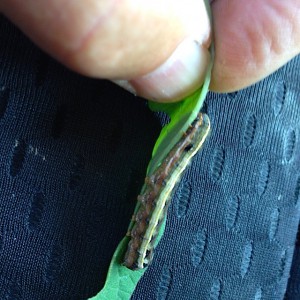Sweet Corn
Cool night temperatures and a declining late European corn borer (ECB) generation have resulted in very few moth captures this past week (see ECB map). Damage from this pest is largely being overshadowed by that of the fall armyworm. Very few plantings remain that are not silking. However, consider treating when the number of infested plants in a 50 plant sample exceeds 12% in any planting that has not reached the silk stage yet.
See the 2015 Commercial Vegetable Recommendations Guide for insecticide choices.
| The highest nightly ECB catches for the previous week are as follows: | ||
| Downer 1 | Pedricktown 1 | |
| Lawrenceville 1 | Princeton 1 | |
| Oldwick 1 | Woodstown 1 | |
Corn earworm moth (CEW) activity remains steady, with low-to-moderate catches throughout the state (see CEW Map). Cooler night temperatures result in lower catches and slower development. At current levels, CEW remains a significant threat to silking sweet corn plantings.
| The highest nightly CEW blacklight trap catches for the previous week are as follows: | ||
| East Vineland 3 | New Egypt 2 | Chester 1 |
| Folsom 3 | Pedricktown 2 | Hackettstown 1 |
| Farmingdale 2 | Springdale 2 | Matawan 1 |
| Georgetown 2 | Tabernacle 2 | Phillipsburg 1 |
CEW moth catches in the limited CEW pheromone trap network in the southern counties have changed very little over the past week. Overall activity is fairly consistent throughout the south, resulting in a broad area where a 3-day silk spray schedule (green area) is recommended (see both CEW blacklight and CEW pheromone maps). 3-day schedules are warranted throughout southern NJ at this time.
| The highest nightly CEW pheromone trap catches for the previous week are as follows: | ||
| Green Creek 27 | Eldora 13 | East Vineland 5 |
| Springdale 20 | Woodstown 13 | |
For silking sweet corn, the following spray schedules are warranted.
Silking Spray Schedules*:
South – 3 days
Central – 3-4 days
North – 4-5 days
Fall armyworm re-infestation rates remain very high. Growers of transgenic (B.t.) corn are now seeing signs of FAW infestation in harvested ears. Under this type of pressure, growers should consider a 5-7 day spray schedule on transgenic sweet corn through the silk period.
FAW do not respond well to pyrethroid insecticides. The most useful products are those in the IRAC group 28 class (Coragen, Exirel, Belt) or the IRAC group 5 class (Radiant, Entrust), or combination products including these classes. See the 2015 Commercial Vegetable Recommendations Guide for insecticides effective against FAW.
Brown Marmorated Stink Bug (BMSB)
BMSB numbers remained very low in NJ blacklight traps this past week. These catches are too low to create a map. It is not likely that there will be any significant captures in light traps for the remainder of the season.
Hawaiian Beet Webworm
Hawaiian beet webworm (HBWW) adults are increasing somewhat in blacklight traps in Atlantic, Burlington, Camden and Gloucester counties and are active through Monmouth, Middlesex and Mercer counties. Larval infestations in the southern portion of the state have been fairly light, but must be monitored for signs of increase. As yet, no infestations have been discovered in Ocean, Monmouth or Middlesex counties.
This pest favors beet greens, Swiss chard and spinach. Damage occurs directly on leaves, with larvae spinning protective webbing on the underside of leaves. Heavy moth populations may be found in dense stands of galinsoga.
Cole Crops
Crucifer downy mildew (CrDM) is now active in some plantings throughout the state. Broccoli and collard greens are especially susceptible to this disease. Signs include sharp yellow spots on the upper surface of older leaves (see photo 1) and whitish sporulation on the lower leaf surface (photo 2). It is best to treat preventively for this disease, as it can be very destructive if not detected quickly and subject to appropriate fungicides. See the 2015 Commercial Vegetable Recommendations Guide for fungicides effective against CrDM.
Tomatoes
Late plantings of high tunnel tomatoes have been suffering from infestations of yellow striped armyworm (YSAW) recently (see photo of YSAW larva). This caterpillar feeds on foliage initially, but often turns to fruit as it grows to full size.In the field, YSAW are heavily parasitized by wasps and rarely result in noticeable injury. In the tunnels, parasites appear to be much less effective.
